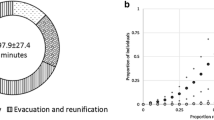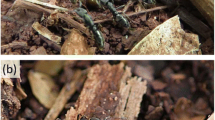Abstract
Colony relocation is an important aspect in the lives of social insects. In ants, the process of relocation is further complicated as brood, in addition to adults, have to be transported to the new nest. Here, we have investigated brood transport in the Indian ponerine ant Diacamma indicum, which uses tandem running—a primitive mode of recruitment—for the entire colony to relocate. We have found that there were no brood transport specialists and most of the brood was transported in the mandibles of followers that were being tandem run. Therefore, in a single tandem run, one adult and one brood item was effectively transported by tandem leaders augmenting the relocation process.

Similar content being viewed by others
References
Avargues-Weber A. and Monnin T. 2009. Dynamics of colony emigration in the ant Aphaenogaster senilis. Insect. Soc. 56: 177-183
Bouchet D.C. and Peeters C. 2013. Both female castes contribute to colony emigration in the polygynous ant Mystrium oberthueri. Ecol. Entomol. 38: 408-417
Dornhaus A., Holley J.-A., Pook V.G., Worswick G. and Franks N.R. 2008. Why do not all workers work? Colony size and workload during emigrations in the ant Temnothorax albipennis. Behav. Ecol. Sociobiol. 63: 43-51
Franklin E.L. 2014. The journey of tandem running: the twists, turns and what we have learned. Insect. Soc. 61: 1-8
Fukumoto Y. and Abe T. 1983. Social organization of colony movement in the tropical ponerine ant, Diacamma rugosum (Le Guillou). J. Ethol. 1: 101-108
Hölldobler B. and Wilson E.O. 1990. The Ants. Harvard University Press, Cambridge, Massachusetts
Kaur R., Anoop K. and Sumana A. 2012. Leaders follow leaders to reunite the colony: relocation dynamics of an Indian queenless ant in its natural habitat. Anim. Behav. 83: 1345-1353
Meudec M. and Lenoir A. 1982. Social responses to variation in food supply and nest suitability in ants (Tapinoma erraticum). Anim. Behav. 30: 284-292
Wilson E.O. 1959. Communication by tandem running in the ant genus Cardiocondyla. Psyche. 66: 29-34
Acknowledgments
Behavioural observation and analyses were carried out by RK. The project was initiated and supervised by SA and funded by Department of Science and Technology (DST) grant, SR/FT/LS-179/2009. RK was funded by Council of Scientific and Industrial Research (CSIR), India. Our experiments comply with the regulations of animal care in India.
Author information
Authors and Affiliations
Corresponding author
Rights and permissions
About this article
Cite this article
Kaur, R., Sumana, A. Coupled adult-brood transport augments relocation in the Indian queenless ant Diacamma indicum . Insect. Soc. 61, 141–143 (2014). https://doi.org/10.1007/s00040-014-0338-6
Received:
Revised:
Accepted:
Published:
Issue Date:
DOI: https://doi.org/10.1007/s00040-014-0338-6




